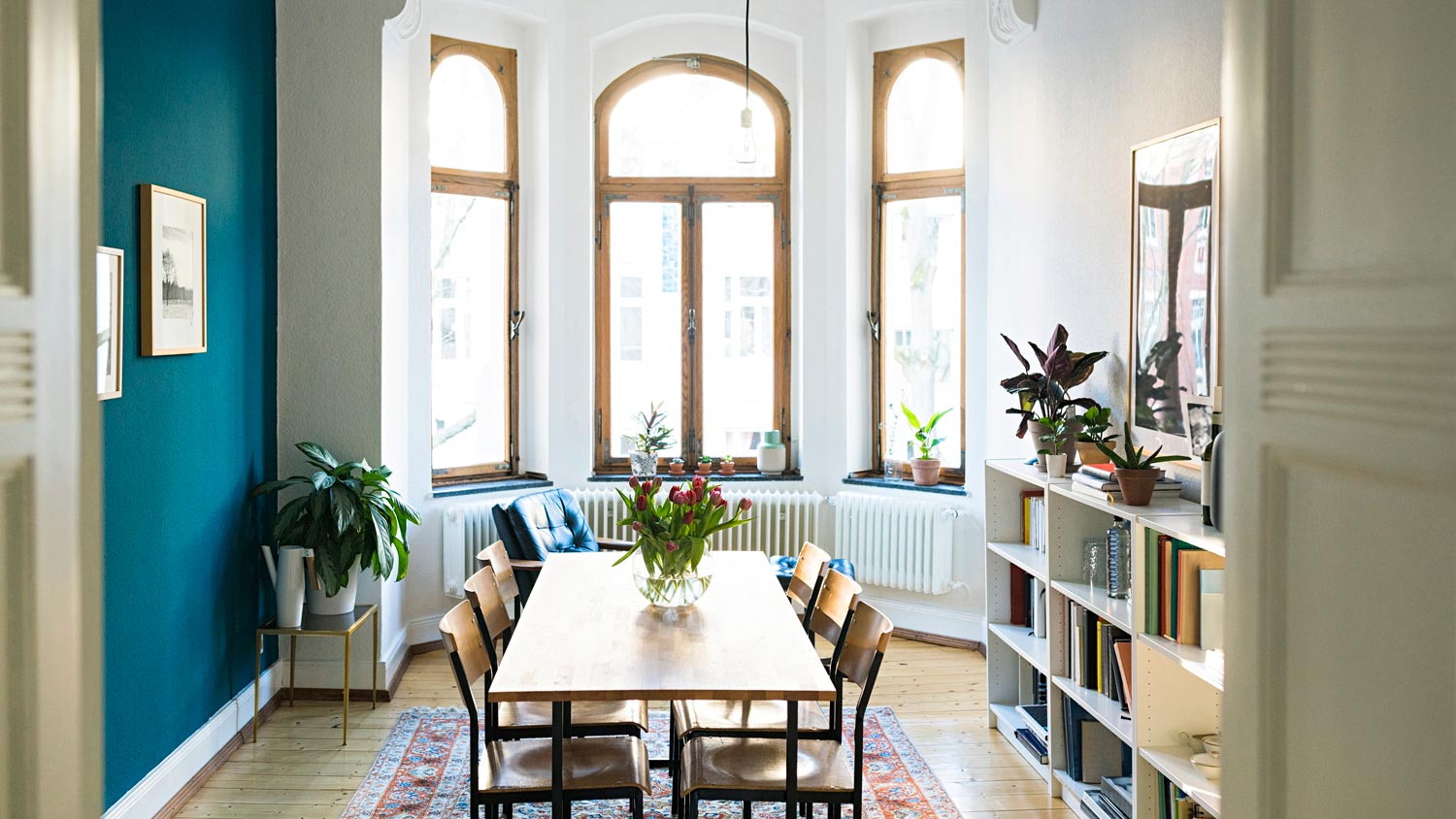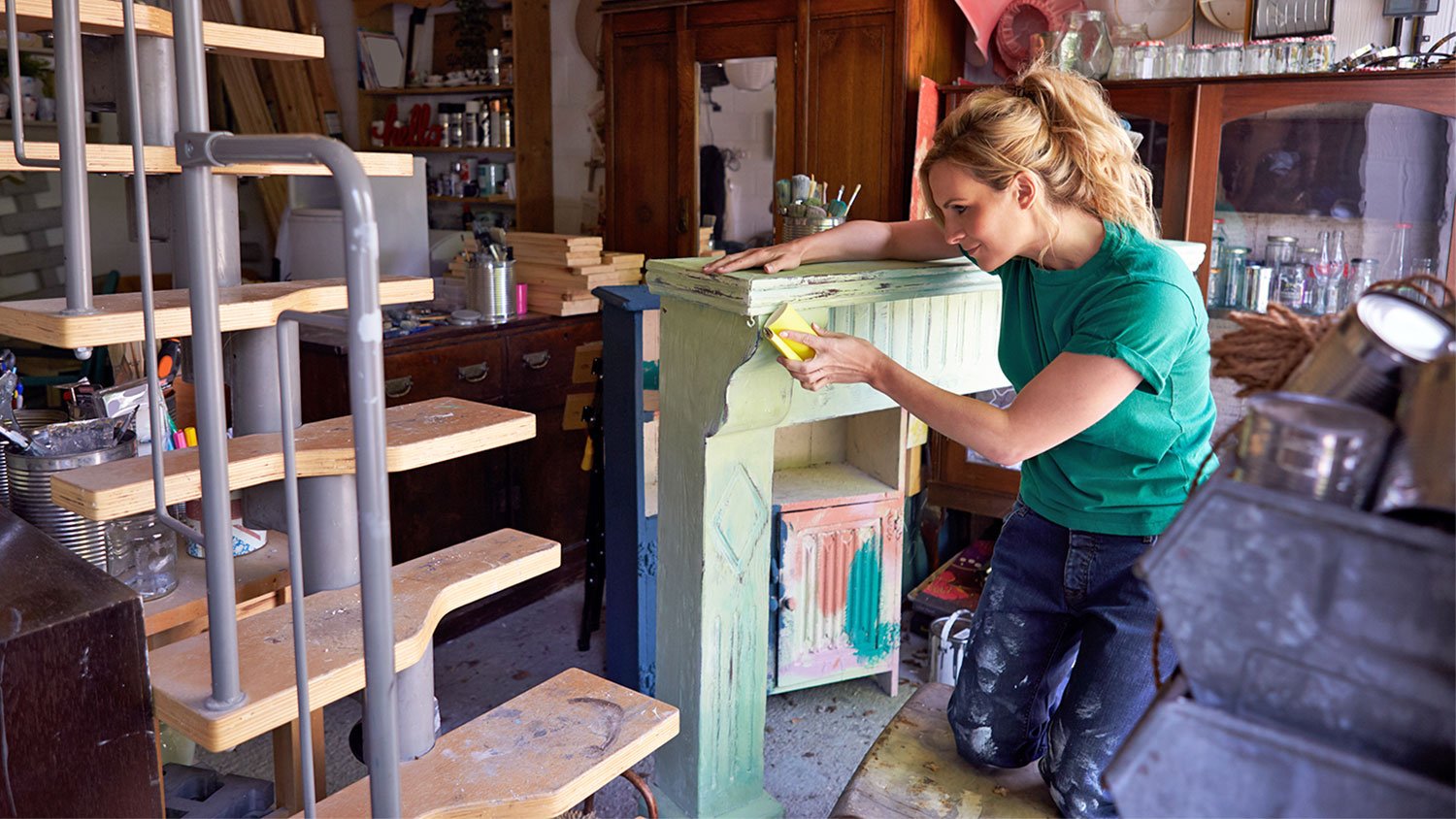How to Protect Furniture From Sun Damage in 5 Easy Steps
Protect your furniture from sun damage, whether it’s indoors or out


- Paintbrush
- Rags
- Wood sealant
- Leather conditioner
Homes with plenty of natural light have an open, welcoming feeling. Natural light also helps boost spirits and energy levels. However, that sunlight isn’t as good for your furniture as it is for you. Protecting your wood, fabric, and leather furniture from UV sun damage takes a small amount of effort for a big payoff.
Seal Wood Furniture
 Photo: Tom Merton / OJO Images / Getty Images
Photo: Tom Merton / OJO Images / Getty ImagesWood furniture is the oldest material used for home furnishings. It gives a living space a traditional, warm ambiance. Sun exposure can be one of the most damaging elements on wood, causing discoloration. Depending on the type of wood, it can fade or darken. You can paint the wood or have the wood refinished, or you can seal it. Sealants not only protect the wood from spills and UVs, but it can also greatly enhance the beauty of the wood grain.
Select the best sealant based on the type of wood you have and how much light it receives on a day-to-day basis. Softwoods, such as pine and cedar, will require more maintenance than hardwoods, such as oak and teak. Your furniture requires a sealant to fight against the sun’s UV rays, but not all sealants are equal. Here are the most common.
Varnish
Varnish is made from resins, oil, and solvents, and it is generally used as a top coat. Like paint, it comes in a variety of finishes, ranging from flat, eggshell, semi-gloss, and high-gloss, and varnish offers excellent protection against ultraviolet light, heat, water, and everyday wear.
Varnish is easy to apply with a brush, and it has low toxicity. However, it does have one of the slower drying times: about 24 hours. Newer, water-based varnish is ideal for indoor furniture due to its fast drying time, durability, and clear nature.
Lacquer
Lacquer is a solvent-based product containing nitrocellulose resin, which allows the coat of lacquer to dissolve into its previous coat. This makes lacquer rather forgiving and easy to apply, polish, and repair any scratches or scuff marks.
Due to its evaporating solvents, it has an extremely fast drying time, creating a hard shell that gives furniture an intense gloss finish and durable, long-lasting protection. However, it's best to be avoided on coarse grain wood, such as oak, or very soft wood, such as cedar.
Polyurethane
Polyurethane is essentially plastic in liquid form (until it hardens). It comes in both water- and oil-based options, as well as satin to glossy finishes. Water-based polyurethane goes on clear, is easy to apply, and has a low toxicity level, but it costs twice as much as oil-based versions.
While oil-based polys add a warm amber color to the wood, it’s toxic and takes much longer to dry. Both kinds are long-lasting and extremely durable, offering protection against scratches and abrasions and making them a popular option among DIYers. However, polyurethane can be susceptible to cracking under heat and sudden shock, making it less ideal for intricately curved furniture or impromptu indoor baseball games.
Shellac
Shellac is a natural product made from the resin of lac bugs and mixed with an alcohol solvent, creating an extremely fast-drying sealant. It brings out the rich warmth of wood grains, while keeping the surface soft and natural. It's especially attractive on walnut, mahogany, and fine veneer woods. It is also easy to apply.
It isn't as durable as other types of sealants, offering only average resistance to scratches and wear, but it holds up to heat. It is best used on decorative pieces that won’t encounter hard wear and tear. Shellac is available in liquid, solid, and flake form, although the liquid variety is best suited to homeowners. It has the shortest shelf life among sealants, so be sure to check the expiration date before using.
Wax and Oil Finishes
These finishes are the easiest to apply, requiring only a rag and some elbow grease. They will enhance the wood, leaving it rich and natural. The ease of application leaves little room for mistakes, but the downside is their lack of durability. Wax and oil offer little protection against the elements and scratches from everyday wear.
Wax and oil require regular maintenance, depending on how often the furniture is used. Most furniture can get by with a new layer every three to five years, while tabletops and chair arms usually require attention every six months to a year.
Rearrange Your Furniture Periodically
 Photo: Westend61 / Getty Images
Photo: Westend61 / Getty ImagesSun damage will cause uneven discoloration on your wood floors if you don't rotate furniture and rugs. Rugs kept in one location on a hardwood floor can show its outlines after a few months or years, depending on how much light is getting into the room.
If you can, rearrange your furniture every couple of months to even out the sunlight’s impact. Pieces that are especially susceptible to sun damage would do best in a shady corner.
Exposing pieces from different angles will lengthen their life and even out their exposure. Moving items on a shelf around frequently—say, every time you dust—will help evenly distribute the wood’s sun exposure, making its effects less apparent.
Choose Light Fabrics
Fabrics are affected by the sun in different ways, and no fabric is 100% safe from damage. Fabrics made of acrylic, polyester, and vinyl hold up much better in the sun than those made of linen or silk, which will fade significantly quicker.
The color of the fabric will make a difference as well. Lighter fabrics will show less fading and darker fabrics will show more fading. Keep that in mind when selecting a chair or sofa fabric for high-exposure areas in your home, such as a sunroom or screened-in porch. Outdoor fabrics are made specifically to stand up to the elements and could be a potential option for your indoor furniture that sits in the sunshine.
After cleaning your upholstery, you might also try a commercial spray-on fabric protector. For an added layer of protection, you can always look into slipcovers. They come in many stylish colors and patterns, and the best part is that they whip off and into the washing machine!
Condition Leather Furniture
.jpg?impolicy=leadImage) Photo: Klaus Vedfelt / DigitalVision / Getty Images
Photo: Klaus Vedfelt / DigitalVision / Getty ImagesSun and leather do not mix well. Sun exposure causes significant fading and drying, especially if it sits directly adjacent to a window. Over time, the leather’s natural oil slowly evaporates, causing stiffening and cracking.
The darker the color, the more prone the leather will be to fading. Once leather has faded, the color cannot be restored without re-dyeing or reupholstering the piece.
Leather Conditioner
In addition to limiting direct sunlight exposure—particularly during the warmer months—conditioning the leather as often as twice a year can help prevent drying and cracking.
Avoid using cleaning products not specifically designed for leather. Retail conditioners are a creamy consistency that you will need to buff into leather. For slightly faded pieces, a color refresh product buffed into the leather can help breathe new life back into it. More serious damage would require you to have the furniture reupholstered. .
It's also a good idea to regularly wipe down your leather furniture and vacuum the creases to prevent dust from building up. These little dust bunnies are responsible for the light fading on the edges often seen on leather sofas.
Install Window Treatments
If you want to make sure your furniture and other belongings are completely safe from UV rays, consider eliminating the points of exposure. Specific laminations for window glass can reduce UV light transmission, diminishing the effect of sunlight.
Blackout curtains, drapes, shades, or window film can block out almost 100% of sunlight. This seems like an extreme measure, but it will also help regulate the room’s temperature, and it is a great step in protecting antique furniture. For a less drastic change, consider installing window awnings.
DIY vs. Hiring a Pro
Deciding whether to go the DIY route or call in a professional comes down to a few things—your budget, how precious your furniture is, and how handy you are. For valuable or irreplaceable furniture, seeking professional guidance and services may be a wise investment. However, for everyday furniture, simple DIY methods can often suffice.
DIY is more cost-effective than hiring a professional. Plus, many types of projects are simple to handle. For instance, homeowners don't need special skills to apply a UV-resistant coating or use furniture covers. But professionals have specialized knowledge and equipment for protecting furniture effectively, which is important when dealing with high-end or antique furniture. Working with a professional with experience in restoration and refinishing will help maintain the beauty and even the value of your precious pieces.
Cost to Get Your Furniture Professionally Cleaned
You might wonder about the price tag when giving your furniture a fresh, clean makeover. Furniture upholstery cleaning costs $120 to $230, but you can expect to pay around $175 on average.
The cost variation boils down to the furniture type, including the materials. You could expect to pay up to $500 to clean a luxurious leather sofa, but one made of polyester usually tops off at $300.
Lisa Gauthier Mitchison contributed to this article.
Frequently Asked Questions
To treat sun-damaged furniture, clean the surface thoroughly to remove dirt and debris. Next, assess the damage: Consider refinishing or applying a protective sealant for faded finishes. Apply furniture oil or conditioner to restore moisture to cracked or dry wood. Remember, the best way to treat your furniture is to prevent damage in the first place. Regular maintenance and preventive measures will keep your furniture looking its best. Lastly, it may be best to consult a professional furniture restorer or refinisher for expert repairs and restoration in severe cases.
Regarding UV protection for furniture, synthetic fabrics like polyester and acrylic are some of the best choices. They have inherent UV-blocking properties and can withstand prolonged sun exposure better than natural fabrics like cotton or silk. Additionally, outdoor-specific fabrics for patio furniture often include UV-resistant treatments to enhance sun protection. Fabrics like these have become softer and more comfortable, making them suitable for interior spaces like sunrooms and other spaces brimming with natural light.
Furniture made from materials resistant to sun fading includes metals like aluminum, stainless steel, and wrought iron, as well as certain synthetic materials like polyethylene (commonly used in outdoor wicker furniture) and resin-based products. Glass tables and accents are also sun resistant. These materials inherently withstand UV rays and are less prone to fading or discoloration. Furniture with UV-resistant coatings or finishes, such as powder-coated metal or UV-protected plastics, offers enhanced protection against sun-induced fading.













